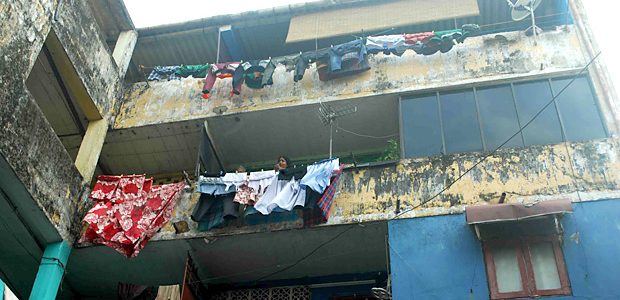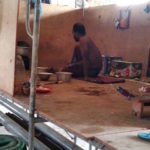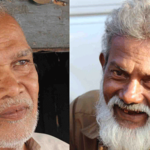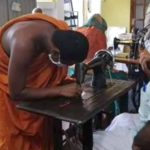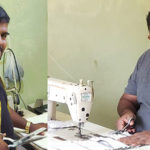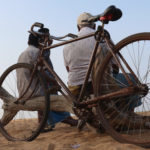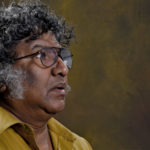An insecure roof over their heads
Maintenance was last carried out in 2003, walls are cracked, roots of trees have found their way inside and the stench of poor sanitation has made life in Vekanda flats a living hell.
“I go to a big school in Colombo. A lot of the (the other students) come from nice big houses. I am ashamed to say where I live because others laugh at me and say, ‘the child living in garbage.’ It is difficult to bear. There is a story that we will get new houses. It will be good if that happens. Then no one will call me ‘Garbage Child,’ said Dinuka Damsara, a resident of Vekanda Vithanage Mawatha on Slave Island, Colombo.
Dinuka is in the fourth grade and like a large number of children in these dilapidated flats, he goes to various schools and no matter where Dinuka goes, he hears the same insult.
The name comes from the serious sanitation issue in the buildings, which are on the verge of collapse. Seven hundred people, or 114 Sinhala, Tamil and Muslim families live in this destitute building.
Built in 1947 the housing was built for families who lost their homes due to other construction projects. No maintenance has been carried out since 2003, which was maintained by an institution under the housing development authority.
Trees have sprung up in random places, covering walls and windows like an octopus. Some roots of trees have damaged concrete pillars and paved the way for water leaks.
Roots of Bo trees have cropped up in kitchens and bathrooms. House owners have tried many times to plaster the walls to cover up the damage.
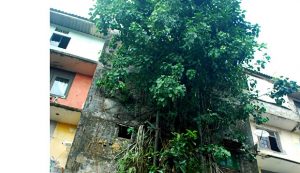
Water clogged areas do not only stink but breed mosquitoes as well. Empty beer cans, empty arrack bottles and cigarette boxes have filled up the empty corners. Lifeless people under the influence of drugs lie about.
Colombo District Human Rights Officer M. M. Thaslin who appears on behalf of these people said these people would be temporarily housed at a housing complex under construction at Madampe. He said the work got delayed as the temporary building to house them was given to Defence College.
“Sinhalese, Tamils and Muslims live peacefully here. There are no clashes among them. They will live peacefully and exemplarily if they go to another place or if this was constructed better,” he said.
Colombo Municipal Commissioner said he could not comment, as this was being done under a project from Urban Development Authority, which The Catamaran was unable to reach. On their website, the authority reports that 50% of the population in Colombo lives in slums, huts and in old flats. The land area of this is 9% of Colombo.
According to a survey recently conducted by the Urban Development Authority, 68812 people live in 1499 family communities like the one Dinuka lives in. The website claimed that families who live in these substandard housing would be provided with facilities recommended according to the urban developments’ plans.
To live like humans
“During Ramalan, government ministers came and told us, as soon as the new year is over, we would be taken to a new place, and a new building would be constructed. They themselves asked us whether we were not afraid to stay here. ‘This may collapse and kill you. Do not stay here. Get ready to leave soon.’ They frightened us,” said M. K. U. Salma,71.
Ramalan has long past. “We are afraid as we do know at what time these houses will collapse and kill us. Where else can we go with these small children? We have no way of living after leaving this place. The only alternative for us is to build these houses again. Walls in my house are cracked. Pieces of concrete fall on us when we bathe,” Salma said.
Ten people live in her two-room flat: her two daughters, son-in-law, her married daughter and her children. The kitchen and toilet are divided by one wall.
The floor is permanently wet. The bed is used to keep food, goods, and for children to read books. Salma, who has spent half of her life imprisoned in this building, has a strong wish to live in a safe, clean and new place during her last phase of life.
“We are still awaiting to be taken to a new place before this building collapses. We would like to live like humans. Everywhere concrete slabs have cracks and iron rods have come up. We request the government to rescue us from this hell.”
/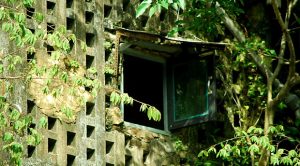
A fear of dying at home
Wadiwelamma said she is prepared to leave Vithanage street today due to her fear of death in these dangerous flats. She said she bemoans the future of her children living there. She lives in the housing unit of Wadiwelamma, with her three sisters, their children, her husband and son. She said she always looks at cracked concrete posts.
“My husband drives a vehicle as his job. My son drives a three-wheeler on rent. All the walls inside my house are cracked. Roots of bo trees grown outside have come inside cracking the plaster of the walls. Several times we plastered the walls and painted. But due to tree roots and water it gets discolored and detached,” Wadiwelamma said.
In these flats, there are 120 families belonging to all communities. Walls of the flats have become a forest. It has happened slowly over the time. One of the reasons is small plants that have not been removed, as small houses around it have blocked the area. Those houses have been illegally constructed. There are about 60 families living in them.
Hopeless future
Parents say the number of children not attending school is higher than the ones going to a school. Residents earn an income by street trading, mobile trading in busses, and other various small businesses.
Organizations studying these housing units claim that some residents spend 80% of their income on drugs.
A small minority can be seen with a higher standard of living by getting an education, marrying outside of the complexes, and getting government jobs. During 4 and 5 pm, women returning from jobs can be seen walking fast, without looking around, covering face and closing their noses before going into their homes.
Meanwhile, the Urban Development Authority’s website claims it will take speedy steps to create 60,000 new housing units in Colombo and its congested areas.
Plans have allegedly been drawn up to build the proposed new housing unit with an area of 400 square feet including two bedrooms, a pantry, a bathroom and a balcony. The Authority also intends to implement a plan on water, electricity and a sewerage system. But it does not when it will be completed, nor when residents would be evacuated from this these unlivable buildings.
